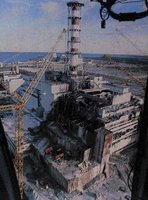 What was the sequence of events? The accident in reactor no. 4 at the Chernobyl nuclear power station took place in the night of 25 to 26 April 1986, during a test. The operating crew planned to test whether the turbines could produce sufficient energy to keep the coolant pumps running in the event of a loss of power until the emergency diesel generator was activated.
What was the sequence of events? The accident in reactor no. 4 at the Chernobyl nuclear power station took place in the night of 25 to 26 April 1986, during a test. The operating crew planned to test whether the turbines could produce sufficient energy to keep the coolant pumps running in the event of a loss of power until the emergency diesel generator was activated.In order to prevent the test run of the reactor being interrupted, the safety systems were deliberately switched off. For the test, the reactor had to be powered down to 25 per cent of its capacity. This procedure did not go according to plan: for unknown reasons, the reactor power level fell to less than 1 per cent. The power therefore had to be slowly increased. But 30 seconds after the start of the test, there was a sudden and unexpected power surge. The reactor's emergency shutdown (which should have halted the chain reaction) failed.
Within fractions of a second, the power level and temperature rose many times over. The reactor went out of control. There was a violent explosion. The 1000-tonne sealing cap on the reactor building was blown off. At temperatures of over 2000°C, the fuel rods melted. The graphite covering of the reactor then ignited. In the ensuing inferno, the radioactive fission products released during the core meltdown were sucked up into the atmosphere.
What caused the accident?Determining the causes of the accident was not easy, because there was no experience of comparable events to refer to. Eyewitness reports, measurements carried out after the accident, and experimental reconstructions were necessary. The causes of the accident are still described as a fateful combination of human error and imperfect technology.
The test during which the accident happened was conducted under time pressure. Shortly after it started, on Friday 25 April 1986, the test run was interrupted for nine hours. Electricity still had to be supplied to the capital, Kiev. The test then took place at night. Today, several flaws in the technical design of the reactor type are thought to have been decisive.
These include the handling of the control rods. In a reactor, the power level is controlled by raising and lowering the control rods: the fewer control rods are positioned between the fuel elements, the greater the reactor power. In this type of reactor, however, the management of the "braking" process has a fatal flaw. If the control rods are raised and then, to "put on the brakes", lowered between the fuel elements, the initial effect is the exact opposite: reactor power is increased.
If, as was the case in the test at Chernobyl, too many control rods are raised at once and then reinserted simultaneously during an emergency shutdown, the power level rises so dramatically that the reactor is destroyed. A similar error, but with much less severe consequences, had already occurred in a reactor of the same type in Lithuania in 1983. This experience, however, was not passed on to the operating crew in Chernobyl.
source: http://www.chernobyl.info/index.php
Een spannend verhaal achteraf teruglezend, grensverleggende technologie die de mens hevig tussen de vingers doorglipt. Het verhaal van de hand vol strandzand: des te harder je knijpt, des te meer zand je kwijt raakt. Een techniek, een versneld natuurlijk proces, dat destijds weliswaar niet in de kinderschoenen stond, maar niet dusdanig geevolueerd was dat de mens volledige controle had. Hoewel het twintig jaar geleden is, slechts twee keer de tijd dat ik in Den Haag woon, heb ik weinig concrete herinneringen aan deze gebeurtenis. Graag had ik een beter geheugen, met name voor de details. De algemene onrust destijds voel ik namelijk nog wel, wanneer ik één van de talloze TV-docu's bekijk. Binnenkort eens met mijn ouders bijpraten, over het toen?
Het is inmiddels weer vrijdag, sinds vijf minuten. Vandaag stralend weer in Den Haag, de zomer komt eraan, en hopelijk een voorbode voor een perfecte Koninginnenach. Vandaag wederom afscheid van een collega genomen. Lina gaat naar de Gouden Gids. Leuke borrel in de Sherlock (Sumatrastraat), daarna nog hapje gegeten met Quint. Die zit nu in de auto naar Rotjeknor, voor een feestje. Succes Quint.
Overigens, ook in Zweden is het koninklijk feest. En wel op zondag 30 April feest: H.M. Carl XVI Gustaf celebrates his 60th birthday April 30th. The birthday programme comprises Friday, April 28 and Sunday, April 30, 2006. Parts of the birthday programme will be broadcast live by SVT, the Swedish Public Service Broadcaster, on Sunday, April 30.
Geen opmerkingen:
Een reactie posten